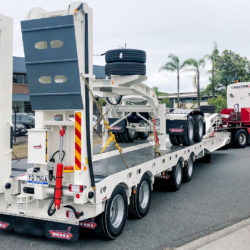{youtube}Fs_O5at0j78{/youtube}
The Performance-Based Standards scheme continues to change the way the nation’s drivers travel across the country. First devised by the National Heavy Vehicle Regulator in October 2007, the scheme uses a set of 16 safety standards and four infrastructure standards to determine if a vehicle is suitable to carry extra loads on the existing PBS-rated road networks. This is so that the right vehicles are matched to the right roads and in turn get matched to the right tasks.
The criteria assess the subject vehicle’s ability to perform in a variety of conditions they could face across Australia’s road network. Tests include, for example, a vehicle’s capability to start on an incline or the maximum width of a swept path on a low-speed 90-degree turn. Other vital examinations of a vehicle’s performance include how much lateral acceleration it can withstand before rolling over or how far the rear tail swings out when taking a corner.
The infrastructure protection requirements are designed to protect roads, bridges and tunnels from the heavy impact trucks can present in certain situations. This encompasses the amount of tyre contact pressure is applied to the road surface, and how much a typical bridge is liable to bend under the weight of a heavy transport trailer’s axle combinations.
Scheme benefits
By being PBS-compliant, truck combinations can take advantage of increased fuel efficiency, take on more loads, have access to PBS-rated roads as well as enjoying the obvious safety benefits. The scheme was made part of National Heavy Vehicle Law in 2014 and managed by the NHVR since 2013, who has been working since to increase uptake of the scheme in the industry.
The NHVR works with state and federal authorities to implement guidelines designed to increase vehicle safety and driver assistance across a wide variety of initiatives. Not only is the PBS under the NHVR’s purvey but they also have a hand in The Agricultural Industry Operators Group to increase vehicle safety awareness and productivity in farms and rural Australia, and the Australian Trucking Associations Safety Truck. The latter tours the country to educate children about the dangers present in being near heavy vehicles and how they can be safe around them.
Additionally, the organisation has established the National Heavy Vehicle Law which covers things like driver fatigue management, the chain of responsibility carried through the entire job, route planning and working with local councils whose jurisdictions are travelled through on the journey.
Spotlight from the ARTSA
The NHVR’s work on the PBS was brought into the spotlight recently at the Australian Road Transport Suppliers Association Global Leader’s Summit held in early May. The ARSTA groups together the industry’s wide range of heavy transport manufacturers, designers and retailers to share information and present new innovations that will impact all levels of the industry, with the PBS being a prime example.
ARTSA chair Dr Peter Hart confirmed that the summit would present an updated report on the PBS uptake and new changes that will make it easier to take part in and implement for owners and operators. Additional speakers at the summit included renowned scientist Dr Alan Finkel and Sal Petroccitto, the CEO of the NHVR.
In part two of this article, we will examine the findings presented at the summit, including the latest figures on industry involvement. In the meantime, contact The Drake Group to find out more about how we support the PBS across our line of heavy haulage trailers.



